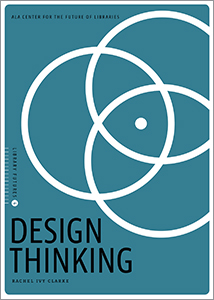Rachel Ivy Clarke on design thinking and libraries
"I think taking a design thinking approach offers possibilities for empathy and creativity," says Rachel Ivy Clarke. In her volume of the Library Futures Series, she delves into the design thinking process model and demonstrates how the viewpoint is applicable to all library products and services. In this interview she discusses how her first library job jumpstarted her interest in design thinking, the difference between user-centered and human-centered approaches, and why libraries should strive for "the surprise of self-recognition."
Congrats on the book! Why did you first become interested in design thinking?
I think I became interested in design thinking because I just kept seeing it everywhere. I do have a lot of design experience in my background, although much of it has been informal. Although I never studied graphic design in school, I did a lot of that kind of work before I became a librarian—I was the  graphic designer for various school newspapers and literary magazines, for example, and I worked for several years as the graphic artist at an awards and promotional products company. (I was laser engraving before makerspaces were cool!) My first library job was at a fashion and design school, where I helped students with all kinds of design projects. I also had done some fashion and costume design work of my own for community theatre shows and art installations. So I think I always had a "designerly" worldview.
graphic designer for various school newspapers and literary magazines, for example, and I worked for several years as the graphic artist at an awards and promotional products company. (I was laser engraving before makerspaces were cool!) My first library job was at a fashion and design school, where I helped students with all kinds of design projects. I also had done some fashion and costume design work of my own for community theatre shows and art installations. So I think I always had a "designerly" worldview.
When I left professional librarianship to work on a PhD, it was because I wanted to solve problems I saw in libraries. For example, I watched students at the fashion school library struggle to find resources for their projects because the way they thought about resources was not the same way those resources were cataloged and organized in traditional library work. For my dissertation, I wanted to build new systems to help library patrons find the resources they were looking for. I took courses in topics like designing interactive computer systems, which drew heavily on approaches like design thinking.
Every time I took a project idea to my dissertation advisor, she asked me to justify why this kind of design approach was appropriate. I kept having to articulate to her all of the connections I was seeing between what I was learning in those classes and all the work I’d done before and all of the relevance and usefulness to libraries. I had a meeting with her one day where I said something like, “For every project I suggest, I’m going to have to make this argument about design and how it’s relevant and appropriate to libraries. What if I just focused on that for my dissertation?” She said that was a great idea, and voila, my dissertation—and the basis for this book from ALA—was born.
What distinguishes design thinking from things like space planning or website design?
Space planning and website design are tasks that result in concrete projects. Design thinking is a mindset, a way of approaching those projects that facilitates creative ideas and helps get at the heart of what those tasks are really trying to accomplish. I can draw on a variety of mindsets to approach a given task. For instance, I could read a book on architectural theory and use those tenets to guide my plan. Or I could read rules and standards for websites and use those to guide what I build online. There may be times and places when taking one of those approaches is useful or necessary. But I think taking a design thinking approach offers possibilities for empathy and creativity in ways that some of those other established approaches do not necessarily include.
For me, it’s like looking at one of those optical illusions—is it a face or is it a vase? Or deciding whether the proverbial glass is half empty or half full. The black and white image, or the glass of water, those are the tasks. What you see in them, how you approach them, that comes from the mindset you bring. If you bring a pessimistic mindset, the glass will be half empty. If you have an optimistic approach, the glass is half full. Design thinking is a mindset, a way of looking at the world, that can be applied to just about any task. I look at that glass from a design mindset and think: is a glass really what we need?
One part of your book talks about user-centered vs. human-centered approaches. Could you briefly explain the difference?
I think of it this way: to base any kind of design on use is reductionist. It only focuses on one task or aspect of a person’s work, say, searching for a book in the library’s catalog. User-based design focuses only on that particular use: how does the person access the catalog, what do they type in the search box, what results are retrieved. That certainly gives us some useful information, but it only gets us so far. When we only focus on use, we don’t take time to understand the human—the person who is doing the using. Who are they? What is their background? Where do they come from? Why do they want that particular book? Do they even want that particular book, or maybe they really want something else they don’t even know or can’t articulate themselves? To take a human-centered approach is to take stock of all this additional context. Taking a more human-centered approach can help us realize that the particular task or use that is occurring might not even be the best solution to a problem. Maybe what the patron needs is not to be searching the catalog at all, but to be engaging in a reference interview with a librarian. But if we only  focus on the use, we might find that, sure, they can search a catalog very effectively, but we won’t necessarily discover that searching the catalog is not what will fulfill their actual information need.
focus on the use, we might find that, sure, they can search a catalog very effectively, but we won’t necessarily discover that searching the catalog is not what will fulfill their actual information need.
What are some ways you think design thinking can improve the libraries of the future?
I think design thinking and accordant design methods and approaches can help libraries be more innovative and creative, and break free of some loyalty to traditional programs and services that, while perhaps useful in the past, need to evolve in tandem with our society. Harold Nelson and Erik Stolterman, two prominent scholars of design, put forth the idea of what they call design desiderata, or “the surprise of self-recognition.” This is the idea that you don’t know what the solution to a problem is until you see it and then say, "Ah yes, I had no idea that’s exactly what I needed, but it’s perfect.” I think libraries should always be striving for that kind of surprise. Programs and services of desiderata aren’t going to emerge from more needs assessment and user surveys—those only reflect back to us what we already do. But the creativity that comes from design thinking can facilitate new ideas that can lead to the kind of surprise that lets people say, “I didn’t know I wanted that library service, but it’s exactly what I needed.”
Learn more at the ALA Store.
